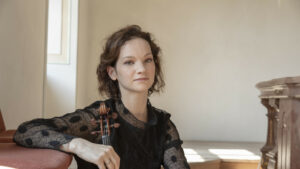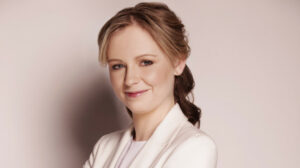Orchestra Wellington – The River
Glen Downie (b. 1991) – Well Within the Madding Crowd
(with Arohanui Strings)
Joseph Joachim – Violin Concerto No 2 (‘Hungarian’)
Soloist: Amalia Hall
Julian Kirgan-Baez (b. 1992) – Reflection
Robert Schumann – Symphony No 3 (‘Rhenish’)
Orchestra Wellington
Marc Taddei (conductor)
Michael Fowler Centre, Wellington
Saturday, 15th October, 2022
There are two rivers in this programme: the Rhine, for which Schumann’s symphony was named, having been written after the Schumanns moved to Düsseldorf, and the Waimapihi Stream, which runs down Aro Valley (albeit mostly underground). Three of the works were written by young men: Joseph Joachim was the youngest, at 27, and Glen Downie the oldest, at 31. Even Schumann was only 40.
There is consequently a sense of possibility, of a sunlit progress towards a happy future, about all of them. The tangible evidence of such possibility was provided by the Arohanui Strings, a Sistema-inspired orchestra led by Alison Eldredge, based in Taita, now with groups in Stokes Valley, Mt Cook, and Miramar. The Glen Downie work was commissioned for them by Orchestra Wellington, supported by SOUNZ, and Arohanui players joined OW on stage to perform it, plus a few other short favourites. It was striking that the Arohanui players took all the outside player chairs, and played with confidence and enjoyment.
Glen Downie had cunningly written a work with easy string parts – most of the interest was provided by the wind, brass, and percussion. It began with a spooky theme on the lower strings, with the broad, appealing main theme influenced by Henry Mancini. Downie’s programme note wished the Arohanui players ‘the same sort of fun … that I had whilst playing his music’. If it was Mancini crossed with film and television music, so much the better.
Marc Taddei’s showmanship was, naturally, evident. After they finished playing their last piece, a Scottish reel, he said encouragingly, ‘That went pretty well, didn’t it? Can we play it faster?’ and swung into a much faster tempo which almost everyone kept up with. Then, as the stage was cleared for the next work, he told the audience exactly how to donate (see arohanuistrings.org).
Joseph Joachim is known best these days as one of the famous violin soloists of the nineteenth century. Brahms wrote for him, as did Schumann. Born in Budapest, he was for several years the principal violinist of the Gewandhaus Orchestra under Mendelssohn, teaching at the Leipzig Conservatory. He moved to Weimar in 1848, where Liszt was establishing his cultural influence, then on to the court at Hanover where he was principal violin, and eventually to Berlin, where he founded a department of music performance at the Royal Conservatory.
As a composer, he was a protégé of Schumann and Mendelssohn. This work is a big virtuosic concerto, lasting 35-40 minutes – and is consequently described by violinists as ‘like running a marathon’. It is not often performed. My Hungarian colleague Steven Sedley commented quietly beforehand that he was a bit surprised that Amalia Hall had agreed to put in the time and effort to learn it. He described it as ‘a showy piece’, designed to show off the virtuosity of the performer. I could immediately see what he meant. It is a challenging work, with a huge first movement and lots of very fast playing required by the soloist. The players from the Arohanui Strings who had crept in to watch were delighted. There was general applause at the end of the movement.
The second movement is a tender and beautiful rhapsody in the style of a Romany ballad, featuring lots of small duets between the soloist and flute (Karen Batten), clarinet (Nick Walshe), and horn (William Loveless), with a long duet with the cello (Inbal Megiddo). The third movement is full of fiery Hungarian themes, as though it was about to launch into a Hungarian dance at any moment. My knowledgeable colleague noted afterwards that the concept of Hungarian nationality was a development of the Hungarian national movement of 1848 and afterwards; and also that gipsy music, emphasising bravura, scintillating music, a strong beat, and rich melodies, was the music played in well-off homes. It is refined music, not raw peasant music.
Amalia Hall played brilliantly by any standard. She captured the rhythmic subtleties and the heart-warming melodic passages. Further, she looked as fresh when she finished as when she started, so she has extraordinary stamina as well as technical virtuosity.
And then the interval. I felt as though I had sat through a whole concert already, but there were still two works to go. That is the nature of an Orchestra Wellington concert.
The next work, Reflection, was by Julian Kirgan Baez, known mainly as an orchestral and jazz trombonist (playing with the Royal New Zealand Air Force Band and the Richter City Rebels as well as Orchestra Wellington and the NZSO). He has also been OW’s ‘Emerging Composer in Residence’ for the past year, working with John Psathas. This work, Marc Taddei told us, ‘embraces the harmonic language of Mahler, Strauss, and early Schoenberg’.
It begins with percussion instruments making sounds like water running over stones, with wind and brass, and then an entry from the strings in the big Mahler/Strauss late romantic style, with a brass underlay. The brass section was big: four horns, three trombones, and a tuba as well as two trumpets – all put to excellent use. The brass and wind writing was, I thought, very assured (although when the principal clarinet switched to bass clarinet I found the sound was swamped by everything else that was going on). Then the spirit of Schoenberg seemed to take over (the programme notes spoke of ‘angular harmonic and melodic gestures’) before a big announcement by the trombones and trumpets, and a final climax. This was an interesting work I would have liked to hear twice. There was excellent playing by percussionist Naoto Segawa and timpanists Brent Stewart and Ben Whitton, as well as trumpets Matt Stein and Toby Pringle and the trombones and tuba.
Finally, the Schumann symphony. The Third is very well known, but for Marc Taddei it was a teachable moment. He explained to the audience how the themes of the four outer movements use the interval of the perfect fourth, but the intermezzo at the heart of the work does not. For people not very familiar with the perfect fourth, the strings’ demonstration of how Schumann conjures beautiful tunes out of such an angular interval (to modern ears) would have sounded like a kind of magic. Taddei also told us that Mahler studied Schumann’s symphonies assiduously – as well as reorchestrating them to suit his own taste. Nor was Mahler the only one – a film composer called James Horner stole the theme from the first movement, turned it from Schuman’s flowing 3/4 into 4/4, and added a shakuhachi (a Japanese flute). There was a burst of music over the PA system to illustrate the point.
This time the music examples were shorter but provided some structure to the listening experience for anyone unfamiliar with the work. The orchestra played well, with great solos from flute (Karen Batten), oboe (Merran Cooke), and great playing by all five horns. I especially loved the Bach-like chorale played by the brass in the solemn fourth movement, Cologne Cathedral, succeeded by the sunny and dancing final movement.
This was a complete musical experience, from the Arohanui kids to the glamour of Amalia Hall’s playing. And Taddei being the salesman he is, there was a pitch for the orchestra’s 2023 season, which includes Bartok’s Miraculous Mandarin, Mahler’s Das Lied von der Erde, Walton’s Belshazzar’s Feast, Psathas’s Planet Damnation (for timpani and orchestra), and Alban Berg’s Wozzek. It is a great overstuffed rich plum pudding of a programme, and I can’t wait.

